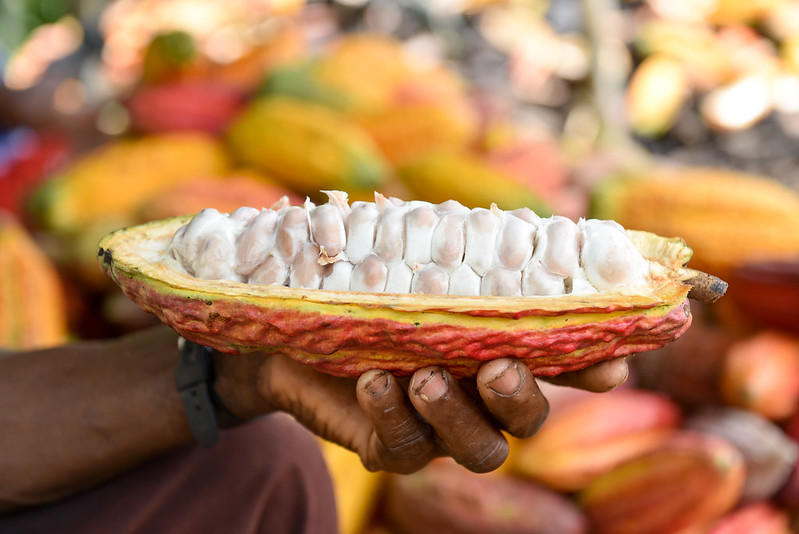Press and News Online tool developed by CIAT helps farmers and buyers interpret EU regulation on cadmium in cacao products

With this year’s implementation of a European Union regulation that strictly limits the amount of cadmium permitted in cacao and its products, farmers and other value chain actors need to know if their cacao can be made into products that meet the food safety standards. This is not straightforward. Different limits apply to different products, depending on the product composition and consumer characteristics. A new online tool developed by the International Center for Tropical Agriculture (CIAT) can help producers, processors, and exporters know if their cacao meet the requirements of the food safety regulation once processed into a product for the EU market.
“There is a misunderstanding of the regulation,” said Mayesse Da Silva, a soils scientist at CIAT’s Agroecosystems and Sustainable Landscapes research area. “Safe levels of cadmium in cacao beans or nibs may well be higher than the level demanded by buyers. The regulation does not apply to raw cacao but to the final product. A safe level depends on the final product that it will be used for.”
Called ChocoSAFE, the tool explains the EU regulation and helps users calculate an estimated level of cadmium allowed in the raw materials – either cacao beans or nibs – for different “recipes” of chocolate products, based on the percentage of cacao ingredients they contain. Cacao ingredients include cacao mass or liquor, cacao butter, and cacao powder. Based on these figures, the tool reverse calculates how much cadmium can be tolerated in the nibs:

For example, the maximum cadmium level of a chocolate bar containing 70 percent cacao mass, according to EU regulation, is 0.8 mg of cadmium per kilogram. The tool calculates a safe limit for cadmium in the raw product (e.g. cacao beans or nibs), meaning the cacao can have a maximum content of 1.1 mg Cd/kg.
A prior analysis of cacao nibs or beans is required to determine the amount of cadmium present in the raw material. The bean husks or shells often contain more cadmium than the nibs or the interior of the beans. It is, therefore, recommended to analyze the peeled beans to have a more accurate figure that is representative of the raw material used for manufacturing.
Cadmium, a heavy metal, is naturally found in soils and is of special concern for cacao-growing areas in Colombia, Ecuador, and Peru. Trees absorb the cadmium through their roots, and trace amounts find their way into the trees’ cacao pods. Cadmium can accumulate in the human body over time. It is carcinogenic, can cause numerous health problems and, only at very low levels of consumption, it is considered safe.
Uptake of cadmium in cacao trees varies due to different environmental conditions.
You can read more about the subject in this article by Mirjam Pulleman (CIAT) and Marika van Santvoort for the World Cacao Foundation or this LinkedIn blog post.
Undoing confusion
CIAT developed the calculator to help producers navigate the new regulatory framework. Because cacao products are mixed with various additives such as milk and sugar, the cadmium content changes during manufacturing and can be reduced to safe levels. The opposite may happen when processing cacao into cacao powder, as cadmium is concentrated in the dry parts of cacao beans and not in the fatty parts that are removed to make cacao powder.
“For example, it would be perfectly safe to use nibs with a cadmium content above 1.2 mg/kg, when being used in chocolate that has a 50–60 percent cacao,” said Mirjam Pulleman, a senior scientist at CIAT, adding that some buyers mistakenly believe that the cadmium content of cacao raw products may not exceed a maximum level of 0.3–0.6 mg/kg, which can create problems for sellers. “Cacao producers need to be aware of the cadmium levels in their beans and whether they can access the European market under the new regulation.”
The ChocoSAFE tool is a CIAT product that will be improved and further developed within the new multidisciplinary research project financially supported by the EU “Development Smart Innovation through Research in Agriculture” (DeSIRA) initiative that will support the countries to adapt into the cacao-cadmium issue. The project is led by CIAT and includes partners in Colombia, Ecuador, and Peru and will address knowledge gaps and capacity building needs related to cadmium in cacao.
